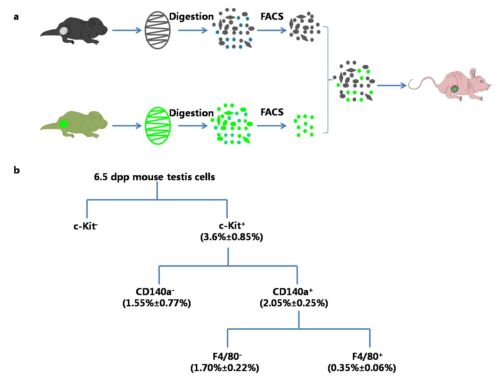
The mammalian testis is a complex organ and provides a host to spermatogenesis, which is one of the most intricate cell divisions occurring in postnatal life. Different types of cells participate in testicular development and play different roles in spermatogenesis. However, there is so far no system that is feasible for analyzing cellular function in postnatal testicular development and spermatogenesis.
Recently, a team of researchers led by Prof. LI Jinsong at the Institute of Biochemistry and Cell Biology, Shanghai Institutes for Biological Sciences of Chinese Academy of Sciences, successfully establish de novo morphogenesis of testis that can be used for investigation of cellular roles in testicular development.
To establish de novo morphogenesis of testis, ZHANG Man and his colleagues subcutaneously injected testicular cells from neonatal testes into the backs of nude mice. They observed testicular tissue formation and spermatogenesis from all injected sites. Importantly, functional spermatids could be isolated from these testicular tissues. Using this system, they systemically analyzed the roles of c-kit+ cells in testicular reconstitution and identified a small population of cells (c-kit+:CD140a+:F4/80+), which were testicular macrophages and were critical for de novo morphogenesis of testis. Interestingly, they demonstrated that these cells were gradually replaced by peripheral blood cells of recipient mice during the morphogenesis of testis.
The results show that de novo morphogenesis of testis, which may mimic the complete developmental process of postnatal testis, can be used for investigating the testicular development and spermatogenesis.
This work entitled “The Roles of Testicular C-kit Positive Cells in De novo Morphogenesis of Testis” was published in Scientific Reports on Aug. 4th, 2014.
This study was supported by grants from the Chinese Academy of Sciences (the Strategic Priority Research Program), the Ministry of Science and Technology, the National Natural Science Foundation of China and the Shanghai Municipal Commission for Science and Technology.
CONTACT:
LI Jinsong
E-mail: jsli@sibcb.ac.cn
Institute of Biochemistry and Cell Biology, Shanghai Institutes for Biological Sciences of Chinese Academy of Sciences,
Shanghai 200031, China

Figure: The diagram and application of de novo morphogenesis of testis.(a) Diagram of de novo morphogenesis of testis. (b) The scheme for identifying that F4/80+ cells are critical in TCDT formation. The percentage yield of each population compared to the starting number of live cells derived from testes is indicated. dpp, days post-partum. (Image by Prof. LI Jinsong`s group)

86-10-68597521 (day)
86-10-68597289 (night)

86-10-68511095 (day)
86-10-68512458 (night)

cas_en@cas.cn

52 Sanlihe Rd., Xicheng District,
Beijing, China (100864)

